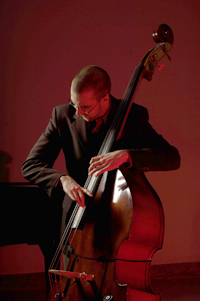|
||
      |
Peer Review ::
Jazz infusion
“I’ve got a song in my head right now,” reports musician Paul Steinbeck.

Paul Steinbeck grooves to eclectic jazz on the bass guitar.
It’s a Saturday night at Low Memorial Library, and the Columbia-Barnard Hillel’s semiformal is getting under way. Young women in slinky dresses dance with each other; one by one, young men cut in. One confidently says to another of the live music, “This is jazz.”
Jazz it is, for the most part. The band, asked to play music to go with the Mardi Gras theme (proceeds went to Stewpot, a Hurricane Katrina charity), gets many attendees on their feet. Tall, lanky, and wearing a near-constant grin, bass guitarist Paul Steinbeck, AB’02, makes playing his instrument look no more difficult than, well, standing there and smiling. Yet when one focuses on the music—and the complex movement of Steinbeck’s fingers—his skill becomes apparent.
“Everything I do is musical in some way,” says Steinbeck, a NYC–based jazz artist and doctoral candidate at Columbia University. “Everything” includes his performances and dissertation—a study of the Art Ensemble of Chicago, a South Side group with multiple U of C connections—as well as everyday life. For Steinbeck, improvisation means “learning how to cross the street in the most stylish fashion,” and adding flourish to teaching, conducting research, and, of course, creating music. “I’ve got a song in my head right now,” he says in a semi-Nebraskan, semi-Southern drawl. The latter, he says, is the influence of his fiancé, Tennessee native and vocalist Candice Ivory, with whom he composes and performs.
On his latest CD, Three Fifths (Paul Steinbeck and Engine Studios, 2005), Steinbeck plays bass, bamboo flutes, and percussion. The songs seem both like old-time jazz and something else entirely, catchy and challenging. Steinbeck describes his music as “adventurous” and “aggressively bouncy,” and counts among his influences Malachi Favors Maghostut, Harrison Bankhead, Tatsu Aoki, Jimmy Garrison, Raphael Saadiq, Pino Palladino, Marcus Miller, D’Angelo, and Slum Village’s Jay Dee.
Steinbeck’s musical life began in the fifth grade, with the trumpet. He took up the bass guitar at his Grand Island, Nebraska, high school, at one point playing in a punk band called the Quonsets.
At Chicago he began learning the acoustic bass. All four years he played with the University of Chicago Jazz X-tet, where he experimented with classic big band, progressive avant-garde, and “the most forward-seeking styles of today and tomorrow.” Through the band he also met one of his mentors, Mwata Bowden, a lecturer and director of University jazz ensembles recently named a Chicago Tribune Chicagoan of the Year for his musical contributions to the city. Bowden, says Steinbeck, showed him that jazz is “coming from a tradition but not being limited” by it.
Music was not always Steinbeck’s master plan. He entered the College intending to concentrate in physics or math, but soon the music courses he was taking for fun became his concentration. His classes with Richard Cohn, a longtime Chicago professor who has since moved to Yale, helped him along. Cohn, says Steinbeck, was “the one who really got me into studying music theory.” Steinbeck calls him “one of the most creative people”—both in his teaching style and in “his way of hearing music”—he has ever encountered: “Let me do the same thing he does.”
In Chicago Steinbeck combined academics and performance. He often hung out at the Velvet Lounge, a South Side club owned by tenor saxophonist Fred Anderson. Steinbeck took his club experience back into the classroom, doing an ethnography and musical analysis of Anderson’s style for his BA paper.
Outside the classroom, he led and co-led groups at nearly all of Chicago’s famous jazz clubs. When deciding on a post-college route, Steinbeck considered the life of a nonacademic musician but was advised against it. “All of my professors,” he explains, “thought I was capable of an academic career but also encouraged my efforts at performance and composition. My professional-musician mentors liked what I was doing musically, but almost all of them advised me that getting a day gig can be helpful because it means you only have to play music for love, not play awful music to pay the rent.”
He still performs in Chicago but more often in New York and elsewhere on the East Coast. His New York gigs range from “club dates” and “society gigs” to shows at the Rainbow Room.
Over brunch at a diner near Columbia, Steinbeck describes a typical day: he spends three or four hours working on his dissertation, teaches ear training (the skill of identifying chords, rhythms, and other musical elements from sound alone), and then performs or practices. What would he be doing if he weren’t a musician? A talent at standardized tests—during college he was an LSAT tutor—briefly led him to consider law school. If he had gone in that direction, he kids, “I’d be nominated for the Supreme Court right now. That’d be awesome.” Part wise-cracking rebel, part serious graduate student, Steinbeck, like his music, refuses to be pegged.